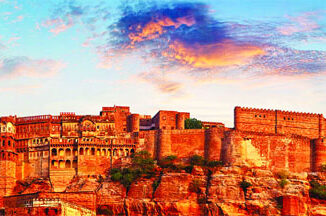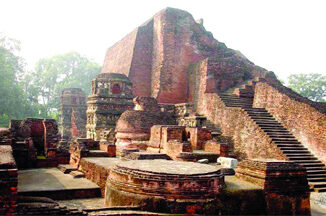Varanasi, or Benaras, (also known as Kashi) is one of the oldest living cities in the world. Varanasi`s Prominence in Hindu mythology is virtually unrevealed. Mark Twain, the English author and literature, who was enthralled by the legend and sanctity of Benaras, once wrote : “Benaras is older than history, older than tradition, older even than legend and looks twice as old as all of them put together. ”
The land of Varanasi (Kashi) has been the ultimate pilgrimage spot for Hindus for ages. Hindus believe that one who is graced to die on the land of Varanasi would attain salvation and freedom from the cycle of birth and re-birth. Abode of Lord Shiva and Parvati, the origins of Varanasi are yet unknown. Ganges in Varanasi is believed to have the power to wash away the sins of mortals. Ganges is said to have its origins in the tresses of Lord Shiva and in Varanasi, it expands to the mighty river that we know of. The city is a center of learning and civilization for over 3000 years. With Sarnath, the place where Buddha preached his first sermon after enlightenment, just 10 km away, Varanasi has been a symbol of Hindu renaissance. Knowledge, philosophy, culture, devotion to Gods, Indian arts and crafts have all flourished here for centuries. Also a pilgrimage place for Jains, Varanasi is believed to be the birthplace of Parsvanath, the twenty-third Tirthankar.
Kashi Vishwanath Temple
Situated on the western bank of holy river Ganga in Varanasi, Kashi Vishwanath Temple is one of the 12 Jyotirlingas or temples dedicated to Lord Shiva. The main deity of Kashi Vishwanath Temple is Lord Shiva, also known as Vishwanatha or Vishweshwarar meaning ‘the ruler of the universe’. The city of Varanasi, the cultural capital of India, is thus known as the city of Lord Shiva. The temple has 800 kg of gold plating on its tower.
Dashashwamedh Ghat
Dashashwamedh Ghat, situated on the Ganges River in Varanasi, holds immense religious significance and cultural vibrancy. Renowned for its daily Ganga Aarti, it offers a mesmerizing experience with spiritual rituals, pilgrim activities, and a lively atmosphere. Every evening, Dashashwamedh Ghat hosts the renowned Ganga Aarti, a spiritual ceremony featuring priests conducting rituals with brass lamps and hymns. This captivating spectacle attracts large crowds, creating a divine ambiance.
Dashashwamedh Ghat serves as a pilgrimage site where devotees take ritualistic dips in the Ganges to cleanse themselves. The ghat’s steps are adorned with numerous shrines, creating a sacred atmosphere. Visitors can engage in boat rides on the Ganges, offering a unique perspective of Dashashwamedh Ghat and the city of Varanasi. The ghat’s proximity to the Kashi Vishwanath Temple adds to its religious aura, creating a significant spiritual hub in Varanasi.
Sankat Mochan Hanuman Temple
The Sankat Mochan Hanuman Temple is situated by the River Assi and was built in the 1900s by the freedom fighter Pandit Madan Mohan Malviya. It is dedicated to Lord Rama and Hanuman. Varanasi is always related to Sankat Mochan Temple and is an essential part of this holy city. Every person visiting Varanasi visits this temple and pay their respects to Hanuman.
The laddoo offered at this temple is essentially famous among the locals.While visiting Sankat Mochan be aware of the monkeys who throng the temple premises and tend to steal away the prasad. However, they are totally harmless if you let them be on their own.
Varanasi has also been a great center of learning for ages. Varanasi is associated with promotion of spiritualism, mysticism, Sanskrit, yoga and Hindi language and honored authors such as the ever-famous novelist Prem Chand and Tulsi Das, the famous saint-poet who wrote Ram Charit Manas. Aptly called as the cultural capital of India, Varanasi has provided the right platform for all cultural activities to flourish. Many exponents of dance and music have come from Varanasi. Ravi Shankar, the internationally renowned Sitar maestro and Ustad Bismillah Khan, (the famous Shehnai player) are all sons of the blessed city or have lived here for major part of their lives.
Arts, Crafts and Architecture of Banaras: You will be amused to see that Varanasi is a Museum architectural designs. It presents changing patterns and movements in course of history. It has a rich and original variety of paintings and sculptor styles and equally rich treasures of folk art. During the ages Varanasi has produced master craftsmen and Varanasi has earned name and fame for its Sarees, handicrafts, textiles, Toys, ornaments, metal work, clay and wood work, leaf and fibre crafts. With ancient crafts, Banaras has not lagged behind in Modern Industries.
The Capital of all knowledge- Discover the most ancient seat of education in India World the famous scholars and their `Shastrarthas’, the great scholars, universities, college, schools, Madarsas and Pathshalas and Guru Shishya traditions, the epics, famous literary works, languages and dialects, journalistic traditions- newspapers and magazine, and famous libraries.
Organisation of sacred complex and social spaces, the cultural pluristic, linguistic and ethnic groups. Discover the city of affluence, intellectuals, oral traditions, castes and customs, personalities, professions, communal harmony . Discover the rural Varanasi. And finally (and with deep insight) peep into, the pleasure of Pans, Thandai, Gamcha, Bahri Alang and Mauj Masti. Banaras has been famous for its Music both vocal instrumental, it has its own dance tradition. Add to this a very rich stock of folk Music and drama (esp. Ramlila), the tradition Musical soirees, fairs and festival the rich tradition of Akharas, games and sports.
Discover the ancient College of Plastic Surgery, Sushruta, Dhanvantri (God of Medicine), Divodas, and practice of all the ancient and modern systems of medicine in action.
Discover the spots around Varanasi, instituions, story of freedom struggle and the martyrs, history of Kashiraj, history of Sarnath, history of Bhadohi (Carpet town), of Mirzapur, of Ghazipur, know about the famous travellers and tourists, of the `Nijam’. And finally having seen the Panorama of Banaras, its continuity of culture, discover the identity of Banaras.
© The Indian Panorama





Be the first to comment